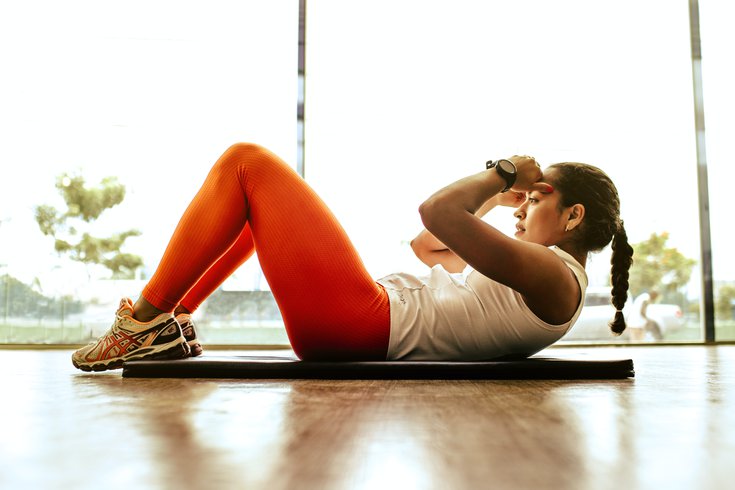
June 05, 2023
 Jonathan Borba/Unsplash
Jonathan Borba/Unsplash
Cycle syncing is a fitness trend that involves tailoring workouts to the varying stages of the menstrual cycle.
One of the latest fitness trends has people keeping the menstrual cycle in mind when planning their workouts.
Cycle syncing, as the trend is known, aligns one's lifestyle with the stages of the menstrual cycle to best work with the hormonal fluctuations experienced throughout the month and attain optimal results.
A typical menstrual cycle lasts between 24 and 38 days, and the four major cycle phases — menstrual, follicular, ovulation and luteal — bring unique physical, mental and emotional challenges. The fluctuating levels of estrogen and progesterone can lead to depression, anxiety, asthma, cramping, bloating and gas, in addition to bleeding, according to the U.S. Office on Women's Health.
With regard to fitness, cycle syncing involves tailoring workouts, and even diets, to these differing stages, rather than doing the same types of workouts throughout the month. Over the last 18 months, the trend has seen a significant uptick in Google searches and gained traction on social media, particularly TikTok, where influencers share how they change their workouts throughout the month to cater to the differing needs of their bodies.
Professional athletes also have utilized cycle syncing. Members of the 2019 World Cup-winning U.S. women's soccer team meticulously tracked their periods to strategize the best forms of preparation for big matches. Major brands have joined in as well, with Nike launching a cycle-adapted program on its Training Club app meant to "harness the power of your menstrual cycle."
Despite its increasing popularity, experts have found that the results of cycle syncing are highly inconsistent, varying from person to person based on the differing lengths of their cycles and varying levels of hormones.
So, how exactly does cycle syncing work and what do experts have to say about it?
During the menstrual phase – when the period occurs – Women's Health recommends rejuvenating exercises like yoga, walking, stretching and pilates, or simply rest if needed.
Next up is the follicular phase, which brings rising hormones and energy levels. This is an ideal time for for high-intensity workouts and heavy weights.
In the ovulatory phase, when the egg is released, hormones are balanced. This brings peak levels of energy, motivation, confidence and mood. During this time, people may want to focus on aerobic training.
The luteal phase is the last phase before menstruation occurs again. This is the time for lower-intensity exercise like swimming, biking, walking, running or pilates.
For people who want to give cycle syncing a go, there are period tracking apps — like FitrWoman (which was used by the U.S. women's soccer team), MyFlo, Cycles and Period Tracker Lite — that can give users an idea of what stages their cycles are in.
The recommendations for the differing types of movement for each stage of the cycle are largely sound, experts say, but there are certain factors that make it difficult to assess the feasibility and results of cycle syncing.
For example, the trend largely assumes each person's cycle follows a 28-day pattern, but research shows that nearly half of women have cycle lengths that fluctuate by about a week, and 20% of women have cycles that fluctuate by two weeks.
Hormones play a large role in cycle syncing's unpredictability, as there are varying estrogen and progesterone levels between people and cycles. Some women completely lack certain hormones due to health conditions.
It also can be difficult and time-consuming to know exactly which phase is occurring without tracking changes using tools like an ovulation stick. Many experts say there is not enough data on the trend.
"I do think it's very important for female athletes to track their cycles," Ellen Casey, a physiatrist from the Women's Sports Medicine Center at Hospital for Special Surgery in New York City, told "Good Morning America." "It's when you try to give a sort of group recommendation that I think (is) where we're falling short to date in the literature, and where I worry that there may be some overselling of cycle tracking and conforming that to your workouts, because we don't have the data to support that as a group effect at this time."
Still, people talking about – and researching cycle syncing – helps give women more information on the stages of the menstrual cycle and its effects on the body.
"Now women are understanding that hey, I might be feeling this specific symptom during this time for this specific reason, so I'm going to be tender with myself," Ava Mainieri, former head of research at the women's health care provider Tia, told The New York Times. "That part is really lovely."
Follow Franki & PhillyVoice on Twitter: @wordsbyfranki
| @thePhillyVoice
Like us on Facebook: PhillyVoice
Have a news tip? Let us know.